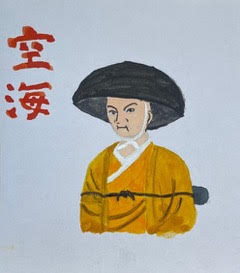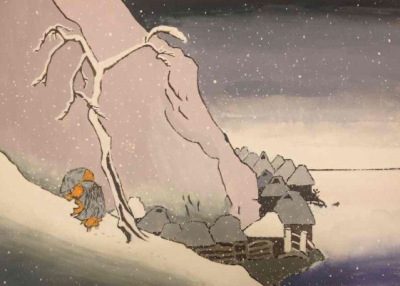Japanese Art and Buddhism: Kukai and Nichiren
Lee Jay Walker
Modern Tokyo Times

Japan’s cultural and spiritual landscape has long been molded by a tapestry of faiths and philosophies—Buddhism, Confucianism, Daoism, and the native Shinto tradition—each leaving its own subtle or profound imprint through the centuries. Yet, among these, it is Buddhism’s (Shinto naturally continues to be a bedrock of Japanese national identity) enduring relationship with art that forms the heart of this exploration—a connection that continues to shape and inspire the soul of modern Japan.
The first artwork is by Inoue Yasuji (1864–1889), a gifted printmaker born in the twilight of the Edo Period. Though his talent began to unfold during the transformative Meiji era (1868–1912), his life was cut tragically short in his mid-twenties. A promising blossom under the tutelage of the revered Kobayashi Kiyochika (1847–1915), Inoue withered before he could fully bloom. His untimely passing left his mentor—and the art world—grieving the brilliance that might have been.

Above is a contemporary interpretation of Kukai (774–835) by the Japanese artist Sawako Utsumi—a modern brush touching the legacy of an ancient soul. Kukai, also revered as Kōbō Daishi, was a luminous Buddhist priest, poet, and scholar, whose spiritual presence is eternally bound to the sacred peaks of Mount Kōya in Wakayama. In the early ninth century, he founded the first Buddhist monastery atop these mist-laced mountains, planting the seeds of the esoteric Shingon school of Buddhism. Central to his teachings was a profound belief: that enlightenment is not a distant goal across lifetimes, but a possibility within a single one—if one truly seeks it.
Sawako Utsumi’s work flows naturally from the spiritual currents of her cultural heritage, drawing upon both Buddhism and Shintoism with quiet reverence. In Japan, whether one follows a particular faith or identifies as secular, there remains a deep, almost instinctive connection to sacred spaces. It is not uncommon for visitors—pilgrims and tourists alike—to offer a silent prayer at a moss-covered shrine or a timeworn temple. From the tranquil paths of Kōyasan and the ancient grandeur of Nara, to the spiritual echoes of Kamakura, Kyoto, Nikko, Chichibu, Ise, Negoro-ji, and beyond, these places are not merely destinations—they are touchstones of something deeper, where the spiritual and the everyday briefly entwine.
Kukai said, “Transient as dreams, bubbles or lightening, all are perpetual travelers.”

The final artwork, also crafted by Sawako Utsumi, turns its gaze to the venerable Buddhist monk Nichiren. Here, he is captured in a moment of profound solitude during his exile on the remote and windswept shores of Sado Island—a time of trial and unwavering faith that forged his enduring legacy.
Among Japan’s many spiritual voices, the 13th-century Buddhist reformer Nichiren (1222–1282) stands out for his passionate belief in the power of individual transformation through devotion to the Lotus Sutra. His teachings, forged in times of turmoil, offered hope to the common people—urging them to see beyond suffering and to trust in the potential of the human spirit. One of his most enduring and poetic lines gently reminds us:
Nichiren said, “Winter always turns to spring.”
https://fineartamerica.com/featured/exiled-buddhist-cleric-nichiren-in-the-snow-sawako-utsumi.html Nichiren
https://fineartamerica.com/featured/kukai-sawako-utsumi.html Kukai
https://fineartamerica.com/profiles/sawako-utsumi Sawako Utsumi and her art
https://sawakoart.com Website of art by Sawako Utsumi

Modern Tokyo News is part of the Modern Tokyo Times group
http://moderntokyotimes.com Modern Tokyo Times – International News and Japan News
http://sawakoart.com – Sawako Utsumi and Modern Tokyo Times artist
https://moderntokyonews.com Modern Tokyo News – Tokyo News and International News
PLEASE JOIN ON TWITTER
https://twitter.com/MTT_News Modern Tokyo Times
PLEASE JOIN ON FACEBOOK